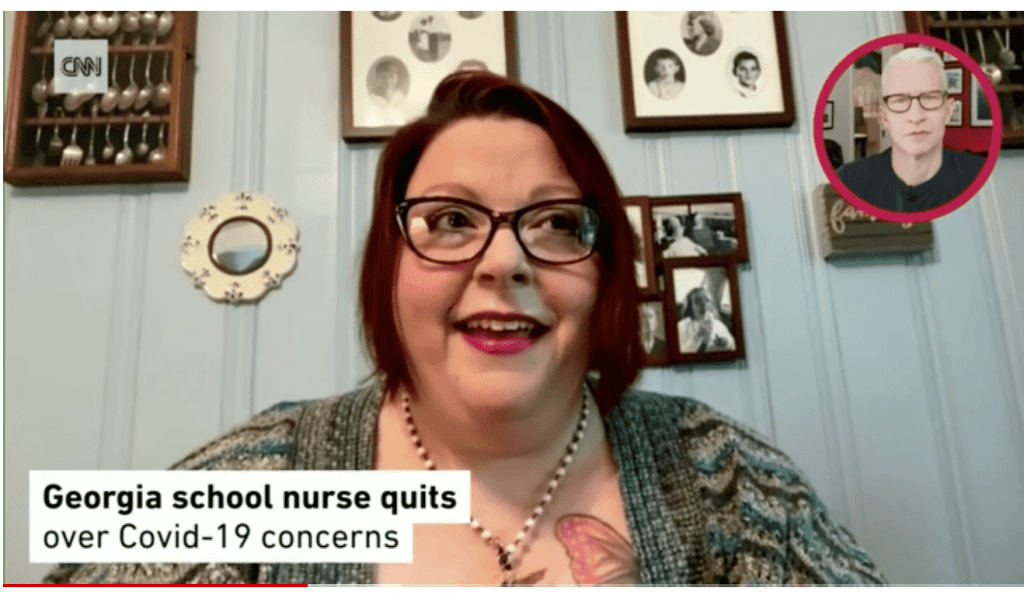I give credit to GA school nurse Amy Westmoreland, who was so concerned over the lack of public health mitigation strategies in her school, she took a stand and resigned from her position. Listen to her compelling reasons, as told to Anderson Cooper from CNN:
See why this school nurse chose to resign
Nurses speak out when we see unsafe practices. So, here I go…We have to ask ourselves, is it safe for school buildings to open this fall? We don’t have a clear answer. Nevertheless, many school districts are moving forward to welcome students back for face-to-face learning despite increasing COVID19 cases and community spread. Our new reality is that schools are the next frontline of COVID-19 with school nurses as the first responders.
We need a precision public health approach to protect ourselves and our children from COVID19. We need leaders who center the safety of children when making decisions that impact health. We are not saying that schools should remain closed. What we are saying is that we need realistic, thoughtful plans in place that equip schools with necessary safety guidelines and resources.
The bare minimum that we need to safely reopen schools is a stable, low rate of COVID-19 in the community; funding for and availability of basic public health precautions including PPE for school nurses and staffworking closely with special populations of students; and access to testing for students and school staff so we know who is safe to be in a building.
We are missing a national plan and on a state level, we have no clear roadmap for testing, tracing, and isolating. We have no large epidemiological studies to fully understand transmission from children and adolescents so that we can make decisions based on evidence. Our students have been protected for the past 5 months, we don’t know what will happen when we return to school.
Dr. Fauci and Dr. Birx recently added goggles and/or face shields to mask-wearing recommendations. We need community buy-in to promote compliance in schools, but we have no national response. It is encouraging to know that in my state of NJ, Governor Murphy announced that masks will now be mandatory in schools.
Right now, these are the ONLY tools we have in our toolbox to keep our students and staff safe at school. Remember the “5 W’s”:
- Wear a mask
- Wash your hands
- Watch your distance
- When you are sick, stay home
- When the health department calls, answer the phone
I could add a 6th W, for windows, opening windows, and doors for improved ventilation. The irony is that we are instructed to lock our doors & windows in response to school shooters & now we need to open our windows & doors to improve ventilation. So which guidelines do we follow? School safety was precarious prior to COVID19. It is now in disarray, propped up with a vague series of ever-changing guidelines. School reopening has become a political football in a country that cannot even agree that wearing masks should be a national response to this deadly epidemic.
While many school districts have developed quality mitigation plans to lower the risk of spread, community transmission is currently too high to adequately protect children and staff. There is a difference between theory and implementation of theory to practice. We do not have wiggle room to make any missteps. Our students’ and staff’s health depends on it.
Current testing capacity is inadequate, test result turn-around times are insufficient, contact tracers are receiving data more than a week old. This is fueling community spread and needs to be improved before schools open for in-person instruction this fall.
Remember, the question that must be answered is “How will we know when it is safe to reopen school buildings?” We need parameters, metrics, a roadmap. Anything less is a guessing game of hope and crossing our fingers and toes that we won’t have an exposure at school. Is that a risk we are willing to take?

Robin Cogan, MEd, RN, NCSN is a Nationally Certified School Nurse (NCSN), currently in her 19th year as a New Jersey school nurse in the Camden City School District. She serves on several national boards including The American Foundation for Firearm Injury Reduction in Medicine (AFFIRM), a gun violence prevention research non-profit organization and the National Board of Certification for School Nurses (NBCSN). Robin is the Legislative Chair for the New Jersey State School Nurses Association (NJSSNA). She is proud to be a Johnson & Johnson School Health Leadership Fellow and past Program Mentor.
She has been recognized in her home state of New Jersey and nationally for her community-based initiative called “The Community Café: A Conversation That Matters.” Robin is the honored recipient of multiple awards for her work in school nursing and population health. These awards include 2019 National Association of School Nurses (NASN) President’s Award; 2018 NCSN School Nurse of the Year; 2017 Johnson & Johnson School Nurse of the Year; and the New Jersey Department of Health 2017 Population Health Hero Award. Robin serves as faculty in the School Nurse Certificate Program at Rutgers University-Camden School of Nursing, where she teaches the next generation of school nurses. She was presented the 2018 Rutgers University – Camden Chancellor’s Teaching Excellence Award for Part-time Faculty.
Robin writes a weekly blog called The Relentless School Nurse. You can also follow her on Twitter at @RobinCogan.


















